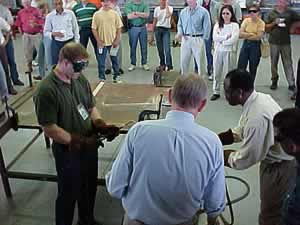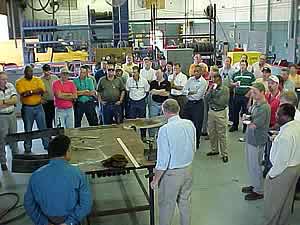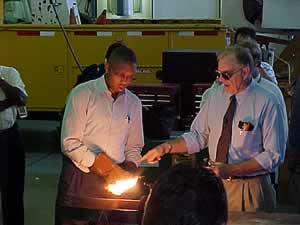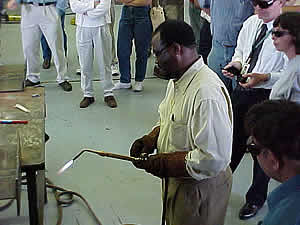U.S. Department of Transportation
Federal Highway Administration
1200 New Jersey Avenue, SE
Washington, DC 20590
202-366-4000
Focus
| Accelerating Infrastructure Innovations |
Publication Number: FHWA-RD-01-068
Date: October 2001
A number of calamities can cause damage to steel bridges, including vehicle impact, earthquake, and fire. While the procedure of heat-straightening has been used sporadically over the past 50 years as a way of correcting this damage, the technique had never been well-documented. To provide guidance to State highway agencies and contractors, the Federal Highway Administration (FHWA) released a two CD-ROM set, Heat-Straightening Repair for Damaged Steel Bridges: An Interactive Guide, in 2000 and will be offering specialized training through a series of 2-day seminars. FHWA has also published a manual, Heat-Straightening Repairs of Damaged Steel Bridges: A Technical Guide and Manual of Practice.
Heat-straightening is a repair process in which a limited amount of heat is applied in specific patterns to the deformed regions of damaged steel in repetitive heating and cooling cycles to produce a gradual straightening of the material. A benefit of using the process is that the repairs generally don't require the temporary shoring of the bridge. Another benefit is that the process can eliminate or greatly curtail the need for traffic detours. When done properly, the heat-straightening technique is an effective and economical approach that can be used in many damage cases. The same principle can also be applied to the fabrication of new bridges for curving or cambering a girder.
The Manual of Practice and CD-ROM provide information on the management and design of heat-straightening repair projects, as well as techniques for using the procedure. The CD also presents a detailed case study of a heat-straightening project on a bridge near Lake Charles, Louisiana. The two-lane bridge crossing on I-10 had been damaged when equipment on a flatbed tractor-trailer impacted a bridge beam. The repair was designed by a team from Louisiana State University and implemented in conjunction with the Louisiana Department of Transportation and Development.
Seminars will be held in Little Rock, Arkansas, on November 27-28, 2001, and in Crawfordsville, Indiana, on December 10-11. Additional workshops will also be scheduled over the next 2 years. The training programs will cover:
Workshops were previously held this year in Topeka, Kansas, and Atlanta, Georgia. The Topeka workshop drew more than 50 attendees, while the Atlanta course attracted nearly 70 participants. "Very useful information was provided in a format that could be understood and applied to what I do at work," said attendee Steve Vaughn of the Georgia Department of Transportation (DOT). "It was one of the best FHWA courses that we have had," noted Paul Liles, Jr., of the Georgia DOT. Don Whisler of the Kansas DOT says, "The materials provided will be great tools to use in the future."
For more information on the workshops or scheduling a training session in your area, or to obtain a copy of the CD-ROM, contact Krishna Verma, Senior Welding Engineer at FHWA, 202-366-4601 (fax: 202-366-3077; email: krishna.verma@fhwa.dot.gov). More information, including a link for downloading the heat-straightening manual, can also be found on the Web at www.fhwa.dot.gov/bridge/heat.htm.
 |  |
 |  |
| The nearly 70 attendees at FHWA's heat-straightening repair workshop in Atlanta got a hands-on introduction to the technique. | |